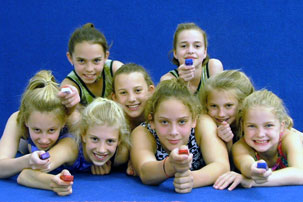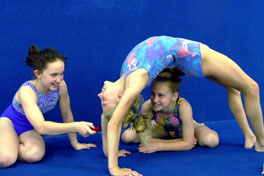When did you last hear third graders in a heated debate about a contracted gracilis muscle? Our little team of 8- through 13-year-old gymnasts has been fascinated lately by anatomy and muscles-the mechanics of gymnastics. They want to know: Which muscles work when? Why? And, by the way, what are the scientific names for those muscles?
The girls I coach in Matthews, NC, want to know so much in order to provide their partners with precise information as they help each other out at practice. To answer all their questions, I had to go out and buy anatomy and movement books for them pore over. (Naturally, I sketched in little shorts and tops for some of the more anatomically correct drawings, as the parents of 8-year-olds might not share in their enthusiasm for early physiological knowledge.)
Why this sudden desire among a group of little girls for the nitty-gritty of anatomy? These gymnasts are being trained in an entirely new way called TAGteachâ„¢. In keeping with its acronym, Teaching with Acoustical Guidance, TAG teachers use a clicker to mark a precise response, action, or position-or "TAG point." The sound of the click becomes an acoustical binary message that is quickly processed by the brain. A "TAG" or click means "yes." Absence of a TAG means "no." Students do not need to process corrections, emotions, or translations while the body is trying to perform complicated movements. Regardless of age or application, the TAG-trained student learns to react to this "data" with lightning-fast speed while building muscle memory and confidence.
An easy example would be the TAG point "feet together in a handstand." The instant a gymnast brings her feet together in a handstand, her partner, be it a coach or a fellow student, clicks. If the feet don't quite make it together, the student doesn't hear a click. She then asks herself, "What's the TAG point? Toes together… Mine must still be apart." She brings the toes to a tight touch, and is rewarded with a click that simultaneously delivers both praise and feedback. The TAGteach method breaks down each skill into its smallest parts enabling both gymnast and coach to pinpoint the movements that make up each skill in the sport. The result is students, even as young as 5, who think through each skill, who know how small movements done correctly build into successful, even spectacular gymnastic feats.
Training my gymnasts with TAGteach has created a point-by-point database in their brains that can be revisited should there ever be a breakdown in performance. They eagerly learn which TAG points are the keys to success and how to replicate that success when they are away from their coach. They take pride in their own contribution, both mental and physical, to their performance. They are motivated at a deeper level than ever before.
Ask any of these little TAG-taughts (or "TAGtots," as we've begun calling them) why they landed on their rump during a beam dismount or why they didn't make their full twisting layout on trampoline. The answer you are least likely to hear is "I don't know." Instead, she will probably name a specific TAG point she thinks needs to be adjusted. "Ooops! I must have let my knees bend on the takeoff." She is just as likely to list the TAG points that were done with perfection. "Did you see that? I landed with my weight pressed equally on both feet." These gymnasts have been given the keys to think through their own performance, identify problems, and find the solutions. TAG, they're it.






Post new comment